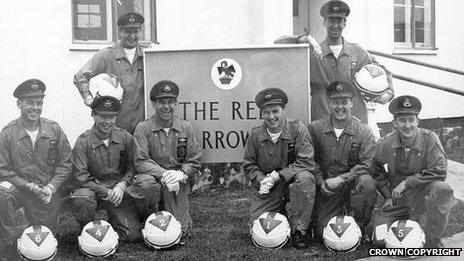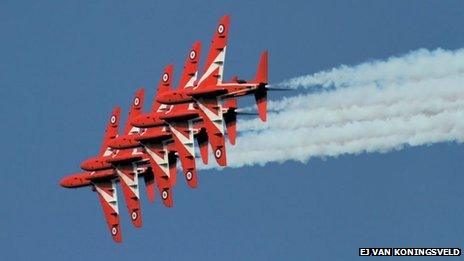How dangerous is life as a Red Arrow?
- Published

It was Sean Cunningham's dream to become a Red Arrows pilot - a dream that ended tragically when he was accidentally ejected from his aircraft and killed.
So how dangerous is life as a Red Arrow pilot?
Flt Lt Sean Cunningham's death could not have come at a worse time for the RAF's world-renowned display team.
His colleague, Flt Lt Jon Egging, had been killed after completing a display at the Bournemouth Air Festival less than three months before.
Two fatalities so close together meant the safety of the team was questioned, and Prime Minister David Cameron told the House of Commons the causes needed to be determined.
"This has obviously been a very tragic time for something that the whole country reveres and loves and I know that their home to them in Lincolnshire is extremely important," he said.
"We must get to the bottom of what happened."

Flt Lt Sean Cunningham, pictured, died less than three months after Flt Lt Jon Egging
Although Jon Egging and Sean Cunningham died within months of each other, fatalities within the Red Arrows are rare.
Ten pilots have died in the 50-year history of the aerobatic display team.
The first fatality, in 1969, happened when a pilot flew into trees during a practice. Two years later, four pilots were killed in a mid-air collision.
Another two pilots were killed in 1978 when an aircraft struck the ground and one pilot died when an aircraft flew into the ground while attempting a manoeuvre in 1988.
More than 20 years then passed with no fatalities, until Flt Lt Egging died in August 2011 and Flt Lt Cunningham died in November 2011.
Photojournalist Keith Wilson worked behind the scenes with the Red Arrows for almost a year, including during the period when Fl Lt Egging and Fl Lt Cunningham died.
"If you look historically at the accident track record for the Reds, aside from 2011, it has been amazing," said Mr Wilson.
"Is it more dangerous than regular flying? From a perspective that you have eight other aeroplanes in close formation manoeuvring around the sky, yes, but those pilots are at the pinnacle of their flying career, and at the peak of their ability."

The Red Arrows team was founded in 1965. Since then 10 pilots have died
But even the deadliest Red Arrows accident, in which four pilots were killed, is incomparable to some of the most serious crashes involving other aerobatic display teams.
In 2002, at the Sknyliv air show in Ukraine, a plane ploughed into the crowd, killing 77 people and injuring nearly 300.
An inquiry into the accident found that the crash happened because the pilot and co-pilot had tried to pull off a risky manoeuvre at a low altitude. The pilots, who ejected from the plane, were jailed in 2005, external.
The Ramstein Air Show disaster in 1988 was also far deadlier than any Red Arrows crash.
Three aircraft from the Italian Air Force display team collided over Ramstein, in Germany, killing three pilots, 67 spectators, and seriously injuring hundreds when one of the aircraft went into the crowd.
Mr Wilson said the Red Arrows displays were "extremely carefully planned and choreographed" and they were not allowed to display in public until they "reach perfection".
"I'm not saying they could do it with their eyes closed, but it's pretty close," he said.
"When they join the Reds they are aware of the risks, which is why they practise so thoroughly and hard until they reach perfection."

Flt Lt Jon Egging crashed in a field on 20 August 2011
So why do pilots feel being a Red Arrow is worth the hard work and potential danger?
"The Red Arrows are without doubt the world's leading formation aerobatic display team," said Mr Wilson.
"To be able to serve with the Red Arrows will clearly be the pinnacle of an RAF pilot's career."
Neither Flt Lt Egging nor Flt Lt Cunningham died performing the breathtaking stunts the Red Arrows are famous for.
Flt Lt Egging crashed in a field before he was due to land, probably because he almost lost consciousness.
And Flt Lt Cunningham had not even flown on the day of his death. An inquest concluded that he died after being accidentally ejected from his plane, while it was still on the ground, due to a problem with the ejection seat.

The Red Arrows are known worldwide for their displays of precision aerobatics
His parachute should have saved his life but the main chute did not open - because a nut and bolt had been screwed together too tightly.
These problems could have caused the death of any RAF pilot who sat in the ejection seat of a Hawk T1, regardless of whether they were a Red Arrows pilot or not.
Despite this, Flt Lt Cunningham's death added to the ongoing debate over the future of the Red Arrows, and whether the cost to the taxpayer is justifiable.
This is often questioned at times of defence cuts, including in August 2010 when MP Jonathan Edwards called for the Red Arrows to be disbanded, arguing the £8.8m a year "could be put to better use".
But as the public face of the RAF, the MoD says the Red Arrows act as "ambassadors of Great Britain, external", promoting industry, contributing to defence diplomacy when displaying overseas, and assisting recruitment into the RAF.
The number of Red Arrows displays has been cut by about 20% following Flt Lt Cunningham's death, to reduce pressure on the team.
But in February, following the latest speculation that the team could be axed, Number 10 said the future of the Red Arrows was safe.
So for now, the team is concentrating on marking the milestone of its 50th display season in 2014.
- Published10 January 2014
- Published9 January 2014
- Published3 May 2013
- Published30 April 2013
- Published16 March 2013
- Published20 February 2013
- Published10 July 2012
- Published9 November 2011
- Published8 November 2011
- Published8 November 2011